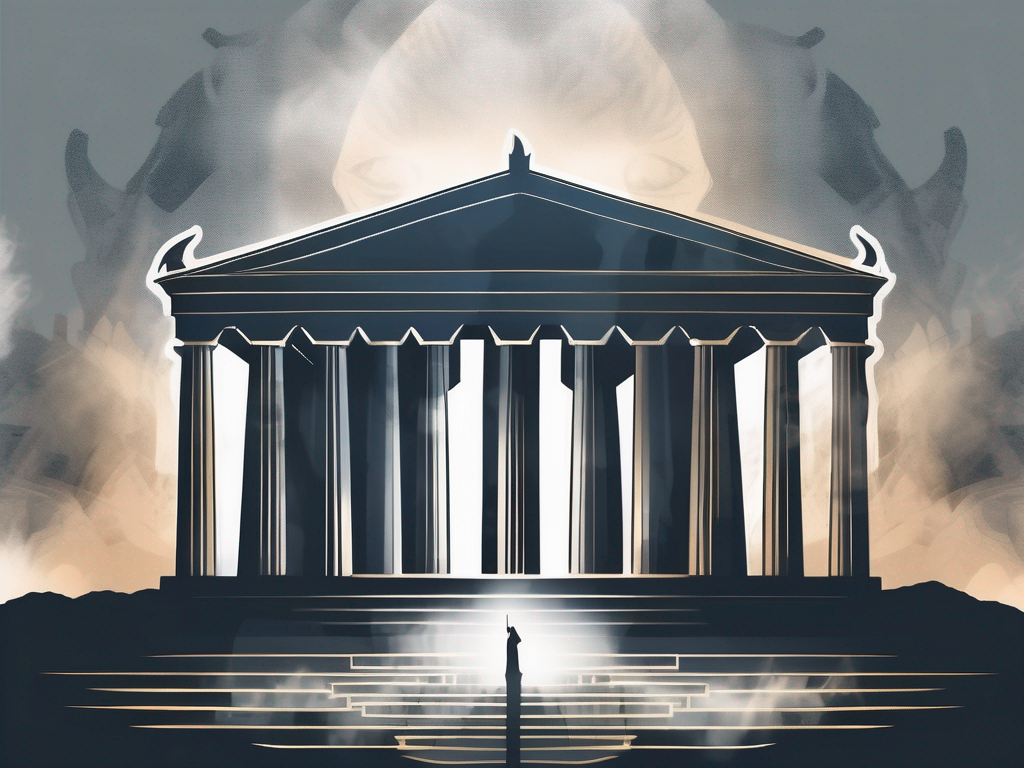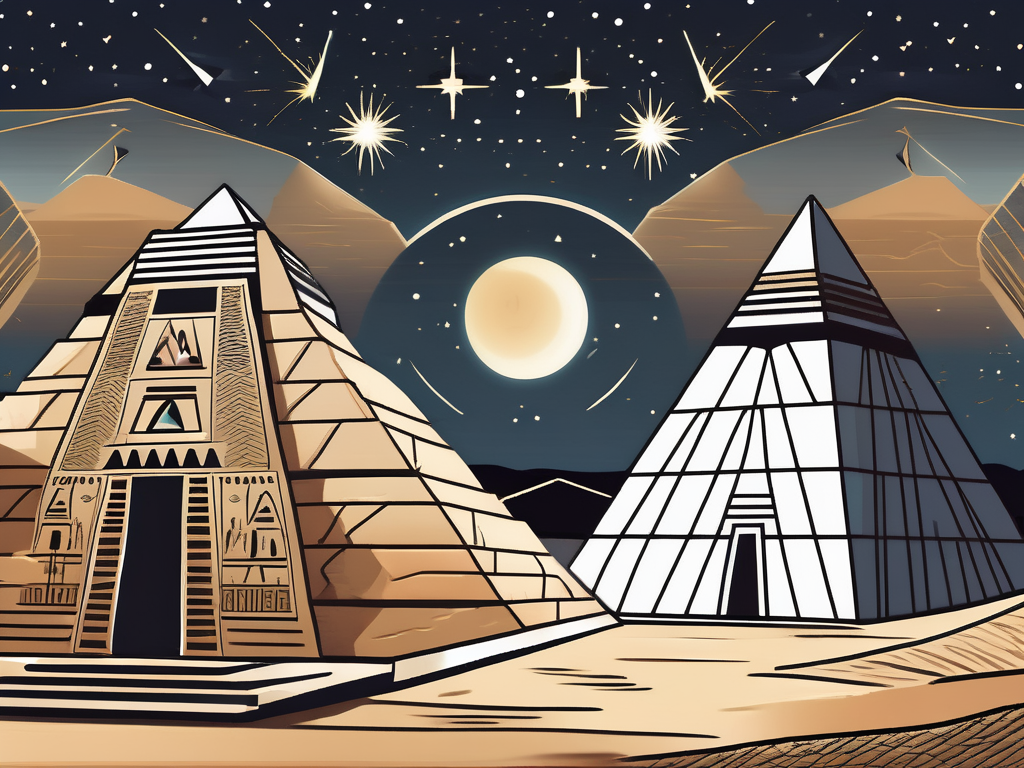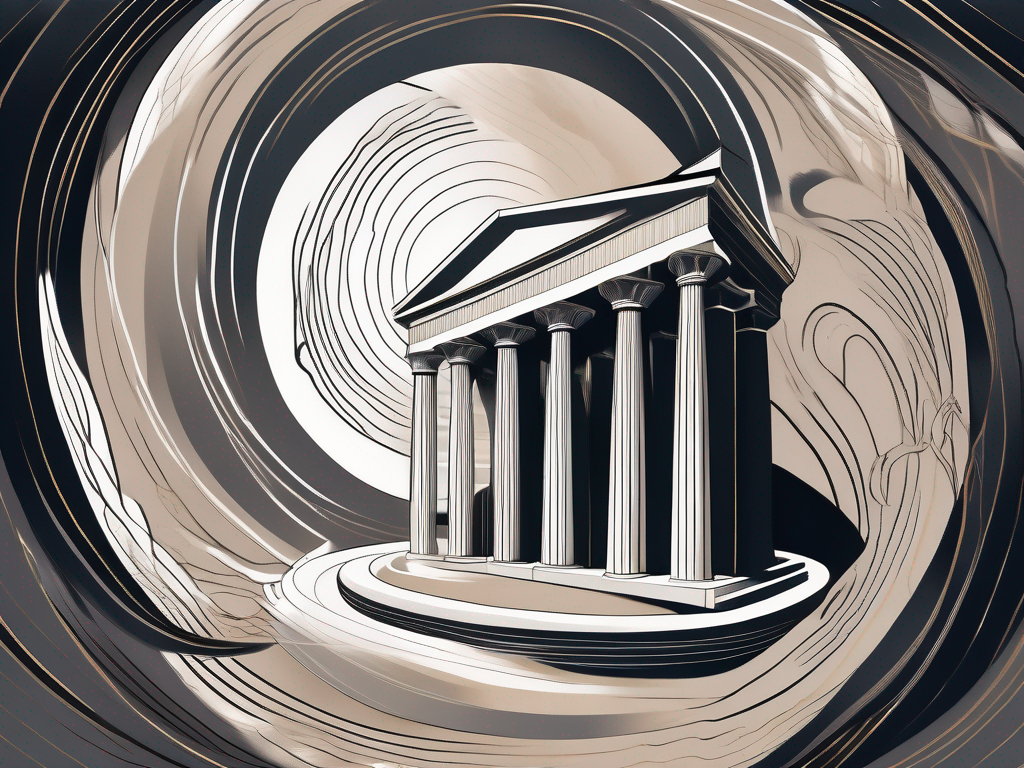Ah, the enigmatic deity known as Heryshaf, whose origins are shrouded in the mists of ancient Egyptian mythology. In this article, we will delve into the depths of this fascinating god, exploring his birth, his role in the Egyptian pantheon, his iconography, the worship devoted to him, his significance in Egyptian cosmology, and his lasting impact on later cultures and religions. Join us as we embark on a journey to unveil the mysteries surrounding Heryshaf.
Understanding the Origins of Heryshaf
Let us start from the very beginning, with the birth of Heryshaf in ancient Egyptian mythology. Born from the primordial waters of Nun, Heryshaf emerged as a creator god, shaping the world with his divine power. This sacred birth myth is testament to the importance and reverence bestowed upon Heryshaf by the ancient Egyptians.
But who exactly was Heryshaf? Within the vast Egyptian pantheon, Heryshaf was regarded as a prominent deity, holding a unique and significant place. Often depicted as a ram-headed god, he symbolized fertility, regeneration, and the power of the Nile. His role in the pantheon was closely intertwined with the agricultural cycle, evoking reverence and adoration from the ancient Egyptians.
The ram-headed depiction of Heryshaf holds deep symbolism. Rams were associated with strength, virility, and leadership in ancient Egyptian culture. By embodying these qualities, Heryshaf became a symbol of power and protection. It was believed that he guarded the pharaohs and guided them in their rule, ensuring the prosperity and well-being of the kingdom.
Furthermore, Heryshaf’s association with fertility and regeneration made him a vital figure in the agricultural practices of ancient Egypt. The Nile River, with its annual flooding, played a crucial role in the fertility of the land. Heryshaf was believed to control the inundation of the Nile, ensuring that the fields were adequately irrigated and fertile for bountiful harvests. His presence was invoked during planting and harvesting rituals, with offerings and prayers made to him to ensure a successful agricultural season.
As a god of regeneration, Heryshaf was also closely associated with the concept of resurrection and the afterlife. Just as the Nile flooded and brought life to the land, Heryshaf was believed to guide the souls of the deceased through their journey in the underworld, ensuring their rebirth and eternal existence.
The cult of Heryshaf was particularly prominent in the ancient city of Herakleopolis Magna, where a temple dedicated to him stood as a testament to his importance. Pilgrims from all over Egypt would visit this sacred site, seeking blessings, guidance, and protection from Heryshaf. The temple was adorned with intricate carvings and paintings, depicting the various aspects and myths associated with this revered deity.
In conclusion, Heryshaf’s origins as a creator god and his association with fertility, regeneration, and the power of the Nile made him a highly revered and significant figure in ancient Egyptian mythology. His ram-headed form symbolized strength and leadership, while his role in the agricultural cycle ensured the prosperity of the kingdom. The cult of Heryshaf flourished in Herakleopolis Magna, where pilgrims sought his blessings and protection. The legacy of Heryshaf continues to captivate and intrigue us, offering a glimpse into the rich and complex belief system of ancient Egypt.
The Iconography of Heryshaf
An exploration of Heryshaf, the ancient Egyptian deity, would be incomplete without a comprehensive discussion of his fascinating and intricate iconography. Ancient art portrays Heryshaf in various forms, but one of the most prominent and recognizable depictions is that of a ram-headed figure adorned with a sacred solar disk on his head. This distinctive iconography served as a powerful visual representation of his divinity and his profound connection to the sun, fertility, and the cosmos.
The ram-headed form of Heryshaf holds significant symbolic meaning. Rams were highly regarded in ancient Egyptian culture, symbolizing strength, virility, and leadership. By embodying these qualities, Heryshaf conveyed his role as a protector and provider, ensuring the well-being and prosperity of his devotees. The sacred solar disk positioned atop his head further emphasized his association with the sun, which represented life-giving energy, enlightenment, and spiritual illumination.
Moreover, the symbolism and attributes associated with Heryshaf’s iconography served to enhance his divine identity. In many depictions, he is shown holding the Ankh, the ancient Egyptian symbol of life, in one hand. The Ankh, resembling a cross with a loop at the top, represented the eternal and cyclical nature of life, as well as the concept of immortality. By wielding this symbol, Heryshaf embodied the essence of life, creation, and the eternal cycle of existence.
In his other hand, Heryshaf often grasps the Was scepter, a symbol of divine power and authority. The Was scepter, characterized by a long staff with a forked end, was associated with the ruling pharaohs and deities, signifying their ability to govern and maintain order in the universe. By holding this scepter, Heryshaf asserted his sovereignty over the forces of nature, the celestial realms, and the divine realm itself.
Through his intricate iconography, Heryshaf conveyed a multitude of symbolic meanings and associations. As a ram-headed figure with a sacred solar disk, he represented the embodiment of strength, fertility, and divine protection. The inclusion of the Ankh and the Was scepter further emphasized his connection to life, creation, and his authoritative role in the cosmic order. The iconography of Heryshaf not only served as a visual representation of his divine attributes but also provided a means for ancient Egyptians to connect with and understand the complex nature of this revered deity.
The Worship and Cult of Heryshaf
Devoted followers of Heryshaf established principal centers of worship throughout ancient Egypt. These sacred sites, such as Herakleopolis Magna, were revered as focal points for connecting with the god and seeking his blessings.
Rituals and festivals dedicated to Heryshaf played a crucial role in the religious and social life of ancient Egyptians. These gatherings, filled with music, dance, and offerings, aimed to honor and appease the god, ensuring fertility, abundance, and bountiful crops for the community.
One of the most significant aspects of the worship of Heryshaf was the belief in his power to bring about fertility and prosperity. Ancient Egyptians saw Heryshaf as a deity closely associated with the Nile River, the lifeblood of their civilization. They believed that by appeasing Heryshaf through rituals and festivals, they could ensure the annual flooding of the Nile, which was essential for the fertility of the land and the success of their agricultural endeavors.
During these rituals and festivals, the followers of Heryshaf would come together in large numbers, creating a vibrant and lively atmosphere. The sound of music and the rhythmic movements of dancers filled the air, creating an ambiance of joy and celebration. Offerings of food, flowers, and other precious items were presented to the god as a sign of devotion and gratitude.
The worship of Heryshaf was not limited to the elite or the priesthood; it was a practice embraced by people from all walks of life. Farmers, artisans, and even the pharaoh himself would participate in these rituals, recognizing the importance of Heryshaf in their daily lives. The belief in the god’s ability to bring about abundance and prosperity united the ancient Egyptians and fostered a sense of community and shared purpose.
At the principal centers of worship, such as Herakleopolis Magna, magnificent temples were erected in honor of Heryshaf. These temples served as a physical manifestation of the people’s devotion and reverence for the god. Elaborate statues and reliefs depicting Heryshaf adorned the walls, capturing his majestic presence and inspiring awe in all who entered.
The cult of Heryshaf also extended beyond the borders of Egypt. As trade and cultural exchange flourished, Heryshaf’s influence spread to neighboring regions, where his worship was adopted by different communities. This expansion of the cult further solidified Heryshaf’s status as a powerful and widely revered deity.
In conclusion, the worship and cult of Heryshaf held a significant place in the religious and social fabric of ancient Egypt. Through rituals, festivals, and the construction of magnificent temples, the followers of Heryshaf sought to honor and appease the god, ensuring fertility, abundance, and prosperity for their community. The worship of Heryshaf transcended social boundaries, uniting people from all walks of life in their shared belief in the god’s power and benevolence.
Heryshaf’s Role in Egyptian Cosmology
Central to Egyptian cosmology, Heryshaf was intricately linked to the Nile River and the fertility it bestowed upon the land. Considered the lifeblood of Egypt, the Nile was seen as an embodiment of Heryshaf’s power and generosity. Ancient Egyptians believed that Heryshaf’s watchful eye guided the annual flooding of the Nile, ensuring fertile soil for agriculture.
Beyond his connection to the Nile, Heryshaf also played a pivotal role as a guide for souls in the afterlife. As the god of resurrection, he provided the deceased with guidance and protection, ensuring their safe passage to the eternal realm of the gods, such as the realm of Osiris.
Heryshaf’s Influence on Later Cultures and Religions
The impact of Heryshaf’s cult extended far beyond ancient Egypt, leaving a lasting imprint on later cultures and religions. In the wake of Alexander the Great’s conquest of Egypt, Heryshaf’s worship blended with Greek and Roman mythologies, giving rise to a unique syncretic deity, known as Hermes Trismegistus.
In more recent times, there has been a revival of interest in Heryshaf worship. Modern interpretations of this ancient god’s teachings and symbolism have sparked renewed fascination and reverence. Seekers of ancient wisdom and spirituality have found inspiration in Heryshaf’s role as a guide through the mysteries of life and the afterlife.
So there you have it, an exploration of Heryshaf, the god whose mysteries have captivated and intrigued us for millennia. From his origins and significance in Egyptian cosmology to his lasting influence on later cultures and religions, Heryshaf continues to hold a revered place in the annals of mythology. Let us embrace the mysteries and celebrate the enigmatic power of this ancient Egyptian deity.












